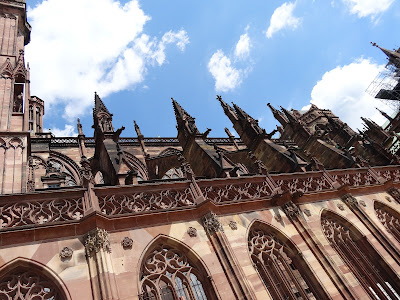The cathedral in Strasbourg is considered one of the finest examples of late Gothic architecture. Construction of the cathedral began in the 12th century and continued until 1439.
 |
| On our way out of the cathedral, we saw this guy. Unlike his little buddies, perched on the walls and ledges of the cathedral, who look down, this gargoyle looks up, proudly, I think, at the façade. This piece is dedicated to all the sculptors who worked on the cathedral. |
Decoration in the cathedral is beautiful, but the most interesting thing is the astronomical clock. There have been three clocks. The first clock served between 1352 and 1574. Construction on the second clock began in the mid-1500s and finished in 1574. The second clock stopped working in 1788 and sat idle until 1838. It was the lifelong dream of Jean-Baptiste Schwilgué to repair the broken clock. In 1838 he realized this dream and spent the next five years replacing the clock's works with his innovative new designs.
 |
| The clock "performs" every day at 12:30 p.m. There is a 2€ entrance fee. |
 |
| The Comput Ecclesiastique, designed by Jean-Baptiste Schwilgué in 1816, performs the Easter computation. This device was able to mechanically figure out future Easter dates on the Georgian calendar long before computers were invented. The First Council of Nicea declared that Easter's date should be, "the Sunday that follows the fourteenth day of the moon that falls on March 21st or immediately thereafter." |
 |
| When the action starts, bells ring and a cock crows. On the upper level, the apostles parade before Jesus. Each apostle swivels to stand face to face with Christ on the way past. On the lower level, four figures, a child, a teenager, an adult, and an old man, walk past Death. |
 |
| The angel tips over his hour glass. |
The clock keeps the official time as well as solar time. It keeps track of the day of the week, the month, and the year and factors in leap years. It shows the real time positions of the sun and moon and calculates the dates of solar and lunar eclipses. It also displays the signs of the zodiac, the phases of the moon, and the positions of several planets.










No comments:
Post a Comment